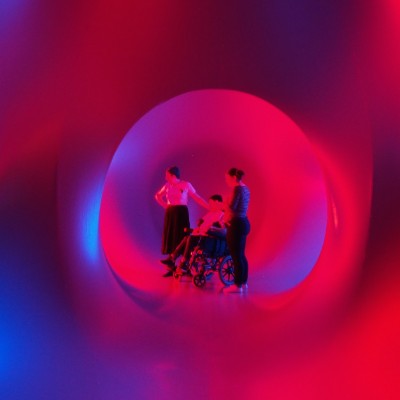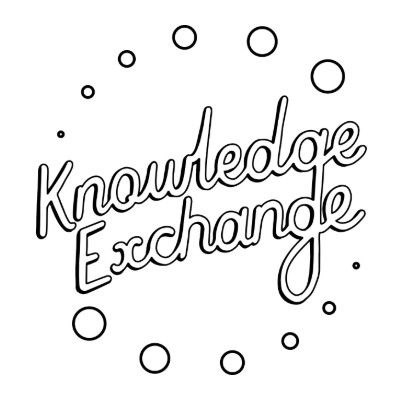Distorted Constellations
22-24 November
Waltham Forest Community Hub (Asian Centre)
Free, just turn up
Distorted Constellations augments reality in this Afrofuturist immersive tech installation.
An exhibition that uses sound, projections and holograms to immerse the audience in the imagined landscape of the artist’s brain.
The brain becomes a fragmented labyrinth inspired by Nwando Ebizie’s rare neurological disorder, Visual Snow. Join her in a visceral new world where reality warps and bends and the cross-modal nature of perception is revealed.
A landscape for transformative encounters. It calls into question how much we can trust our senses through an exploration of atypical perception.
The Antechamber
During Distorted Constellations an adjoining room will be transformed into an antechamber, designed to complement the main installation. Feel free to spend time there before and after visiting the installation.
This space acts as a sensorial refuge and a place to share your experiences and recharge before returning into everyday life. It is a space of relaxation, research and questioning. It is a pocket dimension between the profane world and the sacred. Between the normal everyday and the world of the installation.
Quiet Visits
The soundscape installation will be switched off at certain times over the weekend for those with sensitivities to sound:
Saturday 23 November 11am-12pm and 4pm-5pm
Sunday 24 November 11pm-12pm and 2pm-3pm
Please note there will still be flashing lights during these times.
BSL Tour
There will be a BSL interpreted tour of Distorted Constellations with Nwando Ebizie at 3pm on Sunday 24 November. BSL interpreters will also be available during the day.
Distorted Constellations Closing Salon
Sunday 24 November 7pm - 10pm
Fully booked
Join artist Nwando Ebizie, Neuroscientist Professor Sophie Scott and music journalist Joe Muggs for an evening of performance, music and sensory experiences exploring science, art and ritual to bring Distorted Constellations at Liberty to a close.
Keep scrolling for more information on access at Distorted Constellations.
Part of Liberty –The Mayor of London’s free festival celebrating the work of Deaf and disabled artists, presented in partnership with Waltham Forest London Borough of Culture 2019.
Event categories:
How to get there
Venue: Waltham Forest Community Hub (Asian Centre), 18a Orford Road Walthamstow Village E17 9LN
By bus: W12
By train: Walthamstow Central (Victoria Line, London Overground)
Access Information
For more information about access across Liberty visit wfculture19.co.uk/liberty/access
There are two accessible entrances to Waltham Forest Community Hub on Orford Road, both with a permanent ramp to enter. The width of the ramp or slope is 145cm (4ft 9in). Access to the installation will be by the entrance on the left hand side.
Distorted Constellations consists of a reception area, and two rooms. Room 1 is the Installation Environment (The Brain as Ritual Space). Room 2 is a breakout space (Sensory Antechamber), which you can use if you are tired, overwhelmed or just need a break.
All spaces are wheelchair accessible and there are accessible toilets.
The whole exhibition is on the ground floor.
Opposite the exhibition is a cafe.
BSL Interpreters
BSL trained staff will be available within the venue on Sunday 24 November. BSL interpreters will be available for Distorted Constellations Closing Salon.
There will also be a BSL interpreted tour of the installation with artist Nwando Ebizie on Sunday 24 November at 3pm.
Getting there
The W12 passes along Orford Road (request stop). Walthamstow Central (Victoria Line and London Overground) is an 11 minute walk away (0.6 miles).
On Sunday 24 November, an accessible shuttle bus will stop at Waltham Forest Community Hub, departing regularly from Lloyd Park and Walthamstow Town Hall Cark Park. Click here to find out more about accessible transport.
A number of blue badge parking spaces will be available at Waltham Forest Town Hall Car Park on Sunday 24 November. Once parked, visitors can take the Liberty shuttle bus to Waltham Forest Community Hub.
There are a number of Controlled Parking Zones available around Walthamstow, which blue badge holders are able to use. Badge and clock must be displayed correctly.
What to expect
The main installation space is a large, dark room lit by projected lights and pictures in the form of a labryinth.
There are flashing lights but no strobes. Loud music will be playing continuously.
Gauze and string are hung in the space. You can carefully touch the gauze and the string.
You are invited to watch the visuals and listen to the sound.
You may stand up, sit down or move around.
You may leave the space and return to it at any time.
No more than twenty other people will be in the space at any one time.
There are smells diffused through the space.
Visual Snow
Visual Snow is understood to be a rare neurological disorder. After seeing the exhibition or reading information about it, you may discover that you or somebody you know has Visual Snow.
For more information about it you can contact these organisations:
visualsnowsyndrome.com
visualsnowinitiative.org


